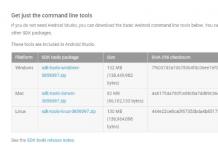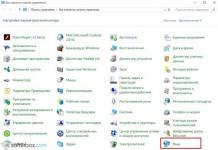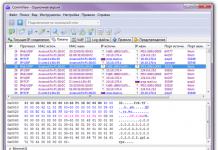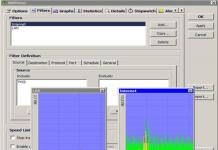The Internet is an integral part of our life. Lack of network is a serious problem for the user. You don't always have time to call your provider, but, fortunately, you can troubleshoot problems yourself. Below you will read about common causes of Internet problems and how to fix them.
Possible reasons for the lack of Internet on Windows 7
There are several reasons for the lack of Internet. Some of them relate to computer drivers and its equipment, others affect system errors and the lack of correct network settings.
The most common reasons for lack of Internet:
- mechanical damage to the cable or ports;
- lack of a network card or its drivers;
- incorrect connection settings on the computer or router;
- presence of virus software.
The Internet may also be unavailable due to a debt on a personal account or due to a line failure. Before you try to troubleshoot problems, check to see if these issues are causing them.
How to check network status
Among the problems with the Internet, we can highlight those that are most common and occur periodically for most users. Resolving them can be very simple. The first thing to do is check the network status.
You can do this in two ways:
In both cases, your network status will be described below your network icon.
Unidentified network without internet access
If the computer “sees” the network and connects to it, but does not gain access to the Internet, the network status will be called “Unidentified network. Without access to the Internet." What to do in this case?
 The computer “sees” the network and connects to it, but does not gain access to the Internet
The computer “sees” the network and connects to it, but does not gain access to the Internet Reboot the router
If you have a router installed, the first thing to do is reboot it. It may simply not have time to update the data, and because of this, access to the network will be lost. The reboot is performed in the following order:
- First, the router is disconnected from the network. It is important to unplug the cord from the outlet, and not to reboot using the button on the equipment - you need to stop the flow of electricity for a while.
- Then the router should be left turned off for 10–15 seconds.
- After this, the router is connected back to the network and wait until the indicators on it light up.
After the indication appears on the router, you can check whether Internet access is available. Usually, after a reboot, the Internet appears within 7–10 seconds.
Checking network settings
Network settings are data that allows the computer to connect to the network distributed by the provider. These settings are issued by the company providing Internet access (usually they are specified in the service agreement). Sometimes the settings on your computer go wrong, and because of this, the device cannot connect to the Internet.
In order to check the network settings, you need to open “Protocol Properties”. You can do it like this:
- Go to “Control Panel” through the “Start” menu.
 "Control Panel" is located in the right "Start" menu
"Control Panel" is located in the right "Start" menu - Select "Network and Internet".
 In order to find the desired section, you should select the “Category” viewing option in the upper right corner of the screen
In order to find the desired section, you should select the “Category” viewing option in the upper right corner of the screen - Open the Network and Sharing Center section.
 In the Network Control Center you can check the connection status, create a new network, and carry out almost any action with your Internet connection
In the Network Control Center you can check the connection status, create a new network, and carry out almost any action with your Internet connection - On the left, find the “Change adapter settings” section.
 Find the section "Change adapter settings"
Find the section "Change adapter settings" - In the list of networks, select the one you need, right-click on it and find “Properties”. Only an administrator can open Properties.
 The desired network will be called “Local Area Connection” or “Ethernet”
The desired network will be called “Local Area Connection” or “Ethernet” - In the list, find the item “Internet Protocol Version 4”, select it by pressing the left mouse button once. After this, the “Properties” button under the list is activated, you need to click on it.
 Selecting an item is done by clicking the left mouse button once. There is no need to uncheck the box next to the item.
Selecting an item is done by clicking the left mouse button once. There is no need to uncheck the box next to the item.
When the window is open, you still need to understand what settings should be entered. There are three options:

Let's figure out what the IPoE and PPPoE protocols are, but we won't go into terminology. It is enough to understand what protocol is used on your communication line. To do this, just look at the network settings issued by the provider (specified in the contract).
The settings can be the following:
- password and login are used on the PPPoE protocol,
- IP address, subnet mask, gateway and DNS are used on IPoE.
If you are using PPPoE and you are connected directly, that is, you are not using a router, after checking the settings through the protocol properties, you need to recreate the network.
- Return to Network and Sharing Center.
 This way only PPPoE connection is configured. To configure a wired IPoE connection, use the protocol properties
This way only PPPoE connection is configured. To configure a wired IPoE connection, use the protocol properties - Open the “Create and configure a new connection” item.
 Switching items is done by single-clicking the left mouse button
Switching items is done by single-clicking the left mouse button - Select "Create and configure a new network" and click "Next".
 The selected item will be highlighted with a bright blue background
The selected item will be highlighted with a bright blue background - Click on the "High Speed" option.
 It may take several minutes to wait while searching for available connections
It may take several minutes to wait while searching for available connections - If an error appears, select “Create the connection anyway.”
 This error appears quite often, but the connection can still be created
This error appears quite often, but the connection can still be created - Next, you will need to enter the network settings, as well as the network name - this is the name of the connection. You can use the name of the provider company or something else.
 The connection name is its name, and the username and password are the network settings. It's worth noting that the password has nothing to do with the Wi-Fi key
The connection name is its name, and the username and password are the network settings. It's worth noting that the password has nothing to do with the Wi-Fi key
After this, the network will be reconfigured, and you will only have to check whether you have access to the network.
Video: checking network settings on your computer
Resetting TCP/IP Settings
Sometimes problems can be caused by internal system errors. TCP/IP is a set of network protocols responsible for data transfer. You can reset it as follows:

Checking drivers
The reason for the lack of access may be outdated drivers (usually this problem is associated with a recent update of the operating system). Let's check their condition.

In addition, by right-clicking on the driver name, you can select “Uninstall”, and then restart the computer. Then when you turn on the system will automatically install the missing driver.
 After removing the drivers and restarting the computer, the system will automatically install the appropriate drivers
After removing the drivers and restarting the computer, the system will automatically install the appropriate drivers If there is an exclamation mark next to the driver icon, you will need to completely reinstall the drivers and check the functionality of the network card installed in the computer.
The default gateway is not available
Network diagnostics will help you detect the following problem. Right-click on your connection icon and select “Troubleshooting”.
 By right-clicking on the icon you can open the “Network and Sharing Center”
By right-clicking on the icon you can open the “Network and Sharing Center” If you receive a message about the gateway being unavailable after performing a system diagnostic, the following steps may help.
Prohibit disabling the network adapter to save energy
Sometimes the system turns off the network adapter - the device that allows you to connect to the Internet - to save power. Try disabling this option.
- Find "Device Manager" through the search bar in the Start menu.
 Opening "Device Manager" through search is not the only way, but it is the most convenient
Opening "Device Manager" through search is not the only way, but it is the most convenient - Expand the “Network Adapters” tab, select the one you need, and right-click on it.
 In the context menu, click on “Properties”
In the context menu, click on “Properties” - Select "Properties" and open the "Power Management" tab.
 Changing these settings will help solve the problem of the Internet disconnecting after the computer goes into sleep mode
Changing these settings will help solve the problem of the Internet disconnecting after the computer goes into sleep mode - Uncheck the box next to “Allow the computer to turn off this device to save power” and save your data.
 After changing the settings, do not forget to save them by clicking on the “OK” button
After changing the settings, do not forget to save them by clicking on the “OK” button
Updating or reinstalling drivers
You can also update drivers through Device Manager: expand the Network Adapters tab, right-click on the network driver and select Update or Uninstall, then restart your computer.
If the action does not help, you can download drivers from their manufacturers' websites and install them yourself. Typically, manufacturers offer to download drivers in an “.exe” file format, so to install, you only need to run the downloaded file and accept the agreement.
Video: how to reinstall drivers yourself
When connecting to the Internet through a router, error 651 occurs
This error occurs when trying to connect using the PPPoE protocol. It is rare, but it happens that users create a new high-speed connection while the provider is using the IPoE protocol. Therefore, first of all, make sure that you are using the PPPoE protocol.
After this, you will need to recreate the connection. The process is described in detail in the “Checking network settings” section (all you need to do is create a new connection through the “Network Control Center”). If this doesn't help, read on.
Disabling antivirus
Sometimes antivirus programs block access to the Internet. Often the solution to the problem is to disable the antivirus. Right-click its icon in the Control Panel and select Disable. Sometimes antiviruses block access to the network even in a “sleep” state, so you can try not only disabling, but also completely removing this software. If this action helps, please report the situation to antivirus technical support.
Problems with the router
The cause of the problems may be several problems related to the router:
- incorrectly connected cable;
- incorrectly entered settings.
First try the following:
- Disconnect the router from the network.
- Without connecting the router, unplug the network cable from it and plug it back into the WAN/INTERNET port, making sure that the plastic clip on the plug clicks when connected.
- If the cable goes from the router to the computer, disconnect it from the LAN connector on the router itself and from the network card connector on the computer, and then connect it back.
- Connect the router to the network.
If access does not appear, check the network settings entered on the router. In order to log into the router, you will need to enter “192.168.1.1” or “192.168.0.1” in any browser (in the address bar). Sometimes the address at which you can log into the router is different, so if you cannot log in through the specified addresses, check the information in the instructions.

Files cannot be downloaded from the Internet
It may also happen that Internet access is active, but files are not downloaded. This problem is usually associated not with the Internet itself, but with the computer and software.
What you can try:
- try to download a file from another source - perhaps you are unable to download something simply because the resource does not support downloading;
- try downloading through other browsers;
- check your computer for malware using any official antivirus.
Multimedia does not work on the Internet
It happens that the Internet works, but video or audio materials are not played. What to do in this case? First, check if the files downloaded to your computer are playable. Perhaps the cause of the problem lies directly in the computer's sound settings. If files are played from your computer, but not from the Internet, read on.
The first thing you need to do is understand why this problem occurs. It may be a browser error or lack of plugins. To get your computer working properly, do the following:

PPPoE diagnostics
Additionally, in order to find out the causes of errors when using PPPoE, you can use the Troubleshooting Center. Then the system will independently check for errors and offer possible solutions.
PPPoE (Point-to-Point Protocol over Ethernet) is a communication protocol over an Ethernet network that operates on a point-to-point basis and provides the user with a number of capabilities: encryption, authentication and data compression. It is necessary for the user authorization system, which makes it easier to track the time of provision and payment of network services.
Right-click the network connection icon and click the Diagnose Problems button. After this, an analysis will be performed, Windows will try to cope with the difficulties on its own, and then prompt you to perform several actions.
Error 619
Restart your computer and disable all security systems: antiviruses and Windows Firewall. The latter is disabled in the following way:

Error 633
There is only one solution:
- Restart your computer.
- Try connecting to the Internet again.
- Create a new connection.
Error 638
Main causes:
- damage to the network cable;
- malfunction of drivers or network card;
- incorrect connection settings;
- problems with network equipment (router);
- presence of viruses on the computer.
First of all, do two things: check the integrity of the cable and the presence of indications on the router. Never neglect these steps when you have problems with the Internet, so as not to waste time trying to solve a problem caused by mechanical damage.
It is clear that if the cable is damaged, you need to call your provider. But if there is no indication on the router (which indicates that the device is de-energized), you should try reconnecting the router to a different outlet before replacing it.
After checking the functionality of the router and the integrity of the cable, check your computer for viruses with any antivirus program.
If the above does not help, recreate the network connection - check the correctness of the entered settings both on the router through its settings, and on the computer itself through the protocol properties. Both actions are described in detail in the previous paragraphs of the article.
Error 691
The only reason for error 691 to occur is an incorrectly entered password and login (network settings). Therefore, the first thing you need to do is recreate the connection. The process has already been described earlier - you need to go to the “Network Center”, select “Create a new connection” and then enter the correct network settings. After this, restart your computer and check your internet connection.
If the action does not help, report the problem to your provider. There may have been a line failure that caused the error.
Error 720
The easiest way to solve this problem is to reinstall the operating system. To do this, just download the operating system file to disk from the Windows website (or purchase the disk in the store) and run it on your computer.
You can also try updating the TCP/IP protocol. The action is described above, but you can also perform a deeper operation by completely reinstalling the stack. Reinstalling the stack yourself is dangerous - you will have to work with system files, and their damage will affect the operation of the computer. Therefore, try simply updating the stack, and if the action does not help, contact your provider or professional technician for help.
Video: connection errors via PPPoE connection and their elimination
Network cable not connected
If, when checking the connection status, a message appears that the network cable is not connected, the first thing to do is actually check that it is connected correctly and is not damaged. If possible, try using a different network cable.
Make sure the cable is connected correctly. On the router, the network cable must be connected to the WAN or INTERNET port, and the cable leading from the router to the computer must be connected to the LAN connector. There is usually only one port on a computer, so it will be difficult to make a mistake.
 The WAN or INTERNET port is used to connect a network cable to the router, and the LAN ports are used to route cables to computers
The WAN or INTERNET port is used to connect a network cable to the router, and the LAN ports are used to route cables to computers Next, check the status of the router (if you have one). Its indicators should light up as usual. If there is no indication, reconnect the router to another outlet, try resetting the settings on the router (using the “Reset” or “Reset” button) and entering them again. You should reset the settings only if you are confident that you can configure the router yourself.
Also check the status of your network adapter drivers and try updating them.
Video: checking the port on the network card and the WAN port on the router
Additional check of security settings
Security settings can also be to blame for many of these problems. This applies to the case when the PPPoE protocol is used. Therefore, if the proposed operations do not help solve your case, try checking your connection security settings.
- Open the "Network Connections" section.
- Right click on your connection.
- Open the “Security” section and set the use of “Unsecure Password” in the list that opens.
These are the main ways to diagnose connections on Windows 7 and troubleshoot problems. Do not forget that the reason for the lack of Internet may be a simple debt or a breakdown on the line. If the methods described above do not help you, contact your provider so that technical staff can diagnose and solve the problem on their end.
A sudden cessation of the Internet does not allow you to complete your planned activities - relax or work, since modern services and games are firmly tied to the Internet. The description of the most common errors collected in the article will help you find a solution and get the Internet working again.
Before you dive into solving the problem at hand, you need to perform a basic check. Recommendations apply to all errors, and often allow you to solve problems that arise with a lack of Internet connection.
- Checking balance. Make sure there are enough funds in your account to use the service. Sometimes providers change the cost of the tariff without prior notice, payment systems do not transfer funds on time, and a failure occurs when the provider withdraws money from the account.
- Check that your login and password are correct. Many companies connect the Internet via PPPoE and provide the subscriber with prepared authorization data. Symbols are often easily confused due to the font, and some letters are not printed. Check with your provider for information. Rewrite the data in a text editor in advance; when copying, make sure that you do not include any spaces. Also make sure to select the entire text and not highlight additional characters if there is additional information in the file.
- Ensure that the cables are connected correctly and tightly. Connect the wires carefully, which is important if you have routers or splitters. Install the cable tightly to avoid disconnection.
- Don't rush into radical decisions. Often, “specialists” working for the provider recommend reinstalling the operating system, whereas the problem was solved by simply rebooting the computer. Re-do previous solutions to problems. If the problem cannot be resolved, reinstall the OS.
If the article does not solve your problem or the methods described do not solve the problem, contact your provider.
Error 619
Reason 1: Incorrect security settings
- Open network connections.
- Select connection properties.
- Click on the “Security” tab and check the settings.

Reason 2: The network card connector is not working or is disabled
Check the functionality of the network card in Device Manager. Make sure the card appears in the list of installed hardware. Install or reinstall network card drivers.

Error 629
Reason 1: session started
Often, when connecting, a double session launch occurs, for example, the dialog box froze and you clicked connect twice. Or the previous session was closed incorrectly. Reconnect after 3-5 minutes or restart your computer.
Reason 2: TCP/IP protocol parameters are not set or reset
Check the IP address and DNS server settings. Sometimes the values are set incorrectly or reset due to a system error. Also check that your login and password are correct.

Error 651
Usually the problem occurs due to problems with network equipment - a modem or router. Sometimes due to a software or hardware failure of the network card. Therefore, it is necessary to double-check the functionality of network devices. Details are described in a separate material available at.
Error 678
There is no connection between the computer and the provider's equipment.
Reason 1: malfunction of the provider’s equipment
Contact your Internet provider and find out the reasons for the lack of network access. Check to see if any repair work is being carried out or if it is possible to remotely check the integrity of the network cable.
Reason 2: Network card/connector failure or malfunction
During power surges or thunderstorms, the network card connector or the entire module burns out. If possible, install a PCI or USB network card and check the connection. Often the problem is solved by reinstalling the drivers.
Reason 3: blocking by antivirus or firewall
Pause the built-in or installed firewall, as well as the antivirus. Review program settings. Sometimes setting a high level of protection leads to blocking of outgoing and incoming requests.



Reason 4: presence of viruses or OS software failure
Restart your computer and check the system for malware. Some Trojans deliberately block access to the network.

Reason 5: Router failure or breakdown
Connect the network cable without a router, check the Internet is working. If the connection is established, the equipment is probably faulty, broken, or the settings are lost.
Error 691
Usually the problem occurs when you enter your username and password incorrectly. After a couple of unsuccessful attempts, the provider blocks the account for a certain period. You need to check the entered data and try again later, after 30-60 minutes, or contact your provider.
Read more about how to solve error 691 in our separate article.
Error 711
The problem occurs when one or more services that are used to connect and maintain the Internet are not active on your computer.
- Open the System and Security section in Control Panel.
- Next is the “Administration” section.
- Find and open Services.
- Find four services one by one:
- Enable broken services. If the service is active, replace "automatic" start with "manual" start. Make sure you are using an administrator account that has the rights to change the state of services.







Error 718
Reason 1: incorrect login or software failure when establishing a connection
Typically, a notification appears when an incorrect login is entered, or the program responsible for the connection is malfunctioning. Therefore, you should double-check the correctness of the entered data, taking into account the case and keyboard layout.
Reason 2: The firewall is blocking the connection
It's unlikely, but it's worth checking your firewall and/or antivirus. Sometimes security mechanisms are configured in such a way that they do not allow the connection to be made.
Reason 3: Incorrect modem disconnection or session termination
More often, the problem lies in incorrectly disconnecting network equipment or terminating an Internet session. You should not disconnect the modem when the Internet is working, or disconnect and reconnect the cable while using the Internet. Another problem occurs when there is a power outage. The problem is usually solved by turning off the computer for 5-10 minutes and turning it on again.
Reason 4: the provider is performing repair work
For some providers that provide services via a USB modem, this error is listed as “performing maintenance work.” Contact your provider's hotline to clarify the circumstances.
Error 720
Reinstall the network card drivers.
Instructions:
- Go to "Device Manager" from "My Computer Properties" or "System and Security" in Control Panel.
- Open the properties of the network adapter.
- On the “driver” tab, click on the update or remove button to reinstall.
- Once the process is complete, restart your computer and try connecting to the network again.

If the problem persists, reset your network settings.
Important! Further actions will change part of the registry, so some programs will stop functioning. Such applications will have to be reinstalled.
Instructions:
- Click "start" on the system menu or keyboard.
- Enter CMD in the search, and then enter two commands in sequence:
netsh int ip reset resetlog.txt;
netsh winsock reset.
- Restart your computer and reconnect to the network.


If both of the above methods do not solve the problem, reinstall the operating system.
Error 769
Usually the problem is related to the modem drivers. Download the latest drivers and perform a clean installation. Afterwards, disconnect the modem, restart the computer, connect the modem and reconnect to the Internet.
Sometimes the problem is with the network adapter. “Turning it off” and then “turning it on” in the “Device Manager” section helps.
Additionally, check your firewall and/or antivirus settings. Sometimes high or manual settings block access to the network.
Error 797
There is no driver for the modem you are using. Download the driver from the official website of the manufacturer and perform a clean installation. When finished, restart your computer.
Error 800
The problem occurs due to the lack of access to the VPN server. Check whether the local network is turned on, and in the VPN server settings, in the “computer name” field, the address is entered – 192.168.1.1. It is better to remove the connection and reconfigure.
Also temporarily disable the firewall and antivirus. If the connection is successful, change the protection settings of the programs blocking the connection.


Error 815
Under this number, the error occurs only on Windows Vista. In other versions of the system, the error code is different - 678, 769 and 651.
Reason 1: Network card failure
Double-check your network card in Device Manager. Open the context menu with the right button, where select “disable”, and after a short time, “enable” the card again in the same way.
Sometimes you need to reinstall or update drivers. The absence of an adapter in the list of connected devices indicates the need to install drivers. If the installation process fails or the drivers do not solve the problem, the network adapter has probably failed and requires careful diagnostics. Alternatively, use an external or built-in network card.
Reason 2: Mechanical fault of the network cable
Double-check the integrity of the wires going to the modem/router and computer. Contact your provider and request the ability to remotely diagnose the cables running to your equipment/computer.
Error 868
The problem occurs in some builds of Windows 7 due to the DNS client not working properly. There is no clear and universal solution, since each case is individual. As an option, sometimes changing the OS or installing another version 8 or 10 helps.
Sometimes reconnecting helps and after 10-20 attempts the connection is successful. You can also use DNS servers 208.67.220.220 or 208.67.222.222.
Conclusion
If you do not have an Internet connection, but know the error code, you can easily find a solution from this article. Some errors occur due to several reasons, so sometimes you need to perform several sequential steps.
For a modern person, the absence of the Internet is something out of the ordinary, since most of us consider the Internet to be our second home. Here you can relax, have fun, socialize, learn a lot of new things and even earn money. When there is no Internet, a person does not find a place for himself and even experiences some discomfort. Today in our article, we will talk to you about why the Internet may not work on a computer, laptop or even tablet.
10 reasons why the Internet does not work
- Line break. This is often the most common reason for Internet shutdowns. That is, it can be not only a cable break, but also a failure of any other equipment responsible for supplying the Internet. To do this, call your provider and report the problem if they are not already aware of the events.
- Poor network coverage (mobile operator). If you use a 3G modem or connect using a mobile SIM card, then the problem may be poor network coverage, which promises constant interruptions and other problems.
- Wi-The Fi router is located far from the computer. If you receive the Internet via Wi-Fi, then perhaps you have gone too far from the signal area, so the network has disappeared. You need to return to the previous place where the Internet worked.
- Your network cable is bent (regardless of where it runs: in the apartment or in the house). Very often, through our own carelessness or the carelessness of the residents of our entrance, we damage the cable through which the Internet runs by placing heavy furniture or other interior items on it. And since the cable is very fragile, the connection to the computer immediately deteriorates, and the Internet signal may disappear altogether.
- The router is frozen. From time to time the router (or it is also called a router) freezes. To do this, you need to remove the power supply from the outlet, wait 30 seconds and put it back in again. As soon as the router is working, the Internet connection will return.
- The network card is frozen orWi-Fi adapter. In addition to the router, the network card in the computer may freeze; to do this, you will have to restart your computer. If the Wi-Fi adapter is stuck (it looks like a flash drive, but it is used to receive Wi-Fi waves), then you need to remove it from the USB socket and put it back in after 30 seconds.
- Disconnected for debts. Try to pay for the services of your Internet provider on time, otherwise they may turn off the Internet for debts. Whether this is true or not, you can find out by calling the provider’s office.
- The Internet is not configured correctly. This usually happens after reinstalling the Windows operating system. You can find out how to set up the Internet in the brochure you received from your ISP.
- Viruses. No matter how trivial it may sound, viruses that block contact may be to blame for the lack of Internet. Check your computer with an antivirus program for pests.

That's all the reasons. Even if you have not been able to determine the reason for the lack of Internet, you should not worry, just contact your provider or computer service center for help, and they will definitely help you!
Today there are two types of Internet connections. The first type is a wired connection, using a cable called twisted pair for connection. The second type is a Wi-Fi connection, which provides an Internet connection using radio waves. Wi-Fi connection has become widespread nowadays. However, wired Internet has a number of advantages that are relevant in large organizations and offices. At home, it also makes sense to make a wired connection to at least one computer. For a stable Internet connection and efficient operation, you must correctly configure its connection parameters.
Benefits of a wired Internet connection
Over the past 15 years, the Internet has rapidly penetrated into all areas of our lives. It is necessary in banking, trade, manufacturing, and is also indispensable for the exchange of information and personal communication. The most common methods of connecting to the global network today are a wired connection and a Wi-Fi connection.
For a wired connection, an optical cable or twisted pair is used. The first type of cable has a significant advantage, as it provides information transmission speeds of up to 1 GB per second. Over twisted pair cable the maximum speed reaches 100 MB per second.
The speed of information transfer through the cable depends on its type and on the network card that receives the signal. This affects the operation of desktop computers, game consoles, televisions and other devices connected to the same network. Streaming information does not require constant exchange between devices, which significantly increases processing speed. The speed of the local connection between workstations is of great importance when working on a corporate network. This is taken into account if there is a need to quickly transfer a large amount of information.
With a Wi-Fi connection, the connection to the Internet is made using radio waves operating in a certain range. Therefore, Wi-Fi is more in demand at the household level. It is convenient because it allows you to immediately connect to the Internet from a smartphone, tablet or laptop anywhere there is an access point. However, signal reception is affected by neighboring devices operating in the Wi-Fi connection frequency band, and by objects in the path of radio waves.
A Wi-Fi connection does not require cables, but it is highly susceptible to radio interference, and the further you are from the access point, the worse the signal reception
A wired connection has a number of advantages over a wireless one:
- the speed of receiving and sending information with a wired connection is approximately 2 times higher than that of Wi-Fi;
- when exchanging files with the server, the delay is minimal, which is important in online games that require maximum speed of action from the user;
- a wired connection is more resistant to network interference; it is not affected by gadgets operating on the Wi-Fi frequency band or nearby sources of electromagnetic radiation;
- The signal strength during a wired connection does not depend on obstacles in the path and the influence of external factors.
Errors that occur when connecting a wired connection may be indicated by codes that indicate the cause of the problem.
Video: why a wired Internet connection is better than Wi-Fi
How to connect a cable to a computer or laptop
Even an untrained user can connect an Internet cable to the computer’s network adapter connector on his own. For connection, a standard cable (twisted pair) with crimped RJ-45 connectors on both ends of the cable is used.
You can connect the cable as follows:
- Prepare a network cable of the required length.
- Connect one connector to any LAN connector on the router.
First, connect the cable connector to any LAN connector of the router
- Connect the other connector of the cable to the connector of your laptop or computer.
Now you need to connect the second connector of the cable to the LAN connector of the computer
- When using an older type of modem, connect the incoming cable from your provider to the yellow Internet connector on the modem.
In older type modems, the provider cable should be connected to the yellow connector of the modem
- Connect the connecting LAN cable to any Ethernet connector of the modem and the network connector of the device.
The connecting cable from the device must be connected to the Ethernet connector of the modem
- After connecting the computer to the router, the indicator LED on the latter will light up, indicating that communication between the devices has been established.
When connecting to a computer, the indicator LED on the router's display panel will light up
Connecting the cable is not very difficult, since all connectors have connectors that fit only into the corresponding sockets on the computer's connector panel. Making a mistake in this process is extremely difficult even for a novice user.
Dynamic and static Internet connection
After connecting the cable connectors and building a connection between the computer’s network adapter and the provider’s equipment, you can debug the Internet connection. First of all, you need to choose a method of connecting to the backbone network, based on specific goals. There are 2 connection methods:
- A dynamic connection is a method in which an individual IP address assigned to a computer is configured automatically and changes when the initial parameters are transformed. The provider company’s equipment independently assigns the network address and default gateway to the computer. When a computer is connected to the main line, the connection to the global network occurs immediately, without requiring additional identification data from the user. The only inconvenience with such a connection is the possible representation of a remote connection to your address. In this case, you must first connect to the trunk line directly, bypassing the router;
- A static connection is a connection method where the individual IP address provided to the computer remains constant and is designated when concluding an agreement with the provider company. During such a connection, the user sets the address manually, and also independently enters the values of the default gateway and DNS servers. If such information is not in the contract, you can find it out in the technical support department of the provider company. Some ISPs may require you to enter a username and password for online licensing. This information is usually indicated in contractual documents or determined by the subscriber independently.
How to create a dynamic connection
To correctly create a dynamic connection, you must perform a number of sequential actions:
From the Start key menu, go to Network Connections
- In the “Settings” section that opens, in the “Changing network settings” block, select “Configure adapter settings.”
In "Options" go to the option "Configure adapter settings"
- In the Network Connections console, right-click the Ethernet connection.
- In the menu that opens, select “Properties”.
From the Ethernet connection drop-down menu, select Properties
- In the Connectivity Console, highlight the IP version 4 (TCP/IPv4) component and click Properties.
In the properties panel, you need to highlight the line IP version 4 (TCP/IPv4), and then open “Properties”
- In the TCP/IPv4 protocol attributes console, enable the “Obtain an IP address automatically” and “Obtain a DNS server address automatically” radio buttons.
In the last step, activate the switches “Obtain an IP address automatically” and “Obtain a DNS server address automatically”
- Click OK to complete.
The dynamic connection is now ready for use.
How to create a static connection
To create a static connection, you need to follow these steps:

That's it, the static connection is established.
Currently, most home Internet subscribers use a dynamic connection, since the main method is to connect through a router. A static connection is used for a modem connection or a direct connection.
When using an ADSL modem connection, only static addresses assigned by your ISP are used.
Video: Creating a Static and Dynamic Connection
How to set up an L2TP connection in Windows 10
The L2TP tunnel protocol, used to connect to the global network, is a symbiosis of the old PPTP protocols from Microsoft and L2F from Cisco. It is easily processed by network devices and has a high speed of information exchange due to reduced processor load. It has great connection stability and high security. Capable of creating tunnels to work in any network. The L2TP protocol is usually used in corporate networks, as it allows you to create a network connection over an existing network. This ensures a stable connection between the organization's main office and regional offices.
To set up an L2TP connection, you need to perform a number of sequential steps:
- Right-click on the Start icon.
- In the menu that appears, click on the “Network connections” line.
From the Start menu, select Network Connections
- In the Settings section that opens, select Network and Sharing Center.
In Settings, open Network and Sharing Center
- Here, select the “Create a new connection or network” option.
In the menu of the “Network and Sharing Center” section, you must select the first item - “Create a new connection or network”
- In the “Configure a connection or network” panel, highlight the line “Connect to a workstation” and click “Next”.
Highlight the line “Connect to a workplace”, then click “Next”
- In the Desktop Connection console, select the Use my Internet connection (VPN) tab.
Click on the “Use my Internet connection (VPN)” tab to continue setting up
- In the console that opens, enter the server address, check the box next to the option “Allow other users to use this connection” and click “Create”.
Enter the server address and don't forget to check the last box to allow other users to use the connection
- In the console that opens, enter your username and password, then connect to the backbone network.
- Go to "Network Connections".
- Right-click on the generated VPN connection.
- Select "Properties" from the menu that opens.
In the console, right-click on the generated VPN connection and go to “Properties”
- In the “VPN connection: properties” console tabs, open the “Security” option.
- In the "VPN Type" field, set the value to L2TP with IPsec (L2TP/IPsec), and in the "Data Encryption" field, select "optional." After that, open "Advanced options".
The VPN type must be set to L2TP with IPsec (L2TP/IPsec), select “optional” for data encryption
- Enter the key provided by your ISP for authentication.
The authentication key must be provided to you by your ISP
- Click OK to complete.
If you did everything correctly, then the L2TP connection is ready for use.
Video: how to set up an L2TP connection in Windows 10
The created L2TP connection increases the level of security for the subscriber and makes it easier to connect to the provider’s equipment.
How to set up a PPPoE connection in Windows 10
The PPPoE Internet protocol is used when connecting to a backbone network using Ethernet technology. This method has a number of advantages, for example, an expanded range of additional capabilities, compression of information during transmission, and carrying out authentication and encryption operations with information packets. Connection requires authorization on the network (entering a username and password). Used for direct connection to the backbone network and provider equipment.
To connect to the Internet using the PPPoE protocol, you must perform a number of operations:
- Open Network and Sharing Center.
- Here, select “Create and configure a new connection or network.”
In the “Network and Sharing Center” section, click on “Create and configure a new connection or network”
- In the “Setting up a connection or network” console, highlight “Internet Connection” and click “Next”.
Select the first item - “Internet Connection” and click “Next” for further settings
- Select the "High Speed (with PPPoE)" tab.
In "Internet Connection" select the connection "High Speed (with PPPoE)"
- Next, enter the username and password received from the provider and click “Connect”.
Enter the username and password received from the provider and click “Connect” to complete the setup
You now have a PPPoE connection established.
Video: how to connect and configure a PPPoE connection
Giving permission to other users to use the connection is only worth it when installing home Internet, since the number of users is limited.
Ways to troubleshoot wired Internet connection problems
When connecting to the wired Internet, errors periodically occur due to equipment malfunctions, a break in the backbone network, or incorrect user actions. In most cases, connection problems arise due to careless actions of the user himself.. To determine and eliminate the cause of the problem, you need to follow simple steps according to the following algorithm:
- Launch Network and Sharing Center.
- In the Network Connections tab, select Troubleshooting.
Go to the Network and Sharing Center and open the Troubleshooting section
- Select "Internet Connections".
For further settings, select the "Internet Connections" option
- Next, click on the line “Run the troubleshooter.”
Wait for the problem detection process to complete
- After the process is completed, in the window that appears, select the “Troubleshoot Internet Connection” tab.
Select "Troubleshoot Internet Connection Problems" and wait for the diagnostic process to complete
- At the end of the troubleshooting process, close the console if no problems are identified. If problems are found, follow the further instructions in the pop-up windows.
- In the next step, under Troubleshooting, open Incoming Connections.
Run the troubleshooter by clicking on the appropriate line
- Once the verification process is complete, in the Incoming Connections console, select Find this computer on the network and click Next.
Check "Find this computer on the network" and continue troubleshooting using the "Next" button
- During the troubleshooting process, follow the instructions that appear on the console.
- If no problems are found, close the console.
- If problems are found, follow the program instructions to resolve them.
This completes checking incoming connections.
The following instructions show how to detect one incoming connection problem. You can find out more about the problem by clicking on the “View additional information” line.

The above method of searching for connection errors is classic and was developed by Microsoft Corporation specialists. In reality, everything can be much simpler, since a problem with the Internet connection can be caused by other reasons that can be eliminated mechanically.
This algorithm helps to resolve the problem of lack of Internet connection in most cases:
- Restart your computer.
- Unplug your router and wait 10-15 seconds.
- Turn on your router.
- If the connection is not restored, click on the Reset button to reboot the router.
To avoid problems with your Internet connection, it is recommended to periodically disconnect your router from the network and give it time to recover.
Video: troubleshooting errors when connecting to wired Internet
Currently, all Internet providers prefer to establish a dynamic connection to the backbone network. This is more convenient for the network subscriber and for the provider company, since it does not require reconfiguring parameters in case of any changes in the network equipment. If you plan to frequently use remote access to your computer, then it is certainly better to choose a direct connection, bypassing a router or modem. For home Internet, you can always change the router settings and connection type initially set by the provider’s specialists. In the future, when the system configuration is changed or a complete reinstallation, the network parameters are set automatically. When connecting directly, the settings will need to be set manually. All this must be taken into account by users when choosing the type of Internet connection.
Share with your friends!

























